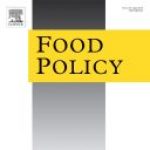Publication type: Journal Articles

Multisectoral Convergence of Food, Nutrition and Sanitation Programs for Child Health: Evidence From Country-Level Programs in India
Abstract This paper underscores the critical role of multisectoral convergence in enhancing child health, particularly in addressing anemia, a micronutrient deficiency linked to both diet and sanitation. We explore how the integration of nationwide food and nutrition programs with sanitation initiatives impacts anemia in Indian...

The Role of Genotyping in Measuring Improved Variety Adoption and Impact: Advances, Challenges, and Policy Directions
Abstract Accurate measurement of agricultural technology adoption is critical for evaluating the effectiveness of investments in agricultural research and development. While household surveys have long served as the primary tool for tracking varietal adoption, growing evidence reveals systematic mismatches between self-reported and DNA verified varietal...

Addressing Information and Credit Barriers to Making India Open Defecation Free and Improving Child Health: Evidence from a Cluster Randomized Trial in Rural India
Abstract Read a policy brief based on this study. Background Open defecation (OD) remains a significant public health challenge in India, contributing to adverse child health outcomes. Eliminating OD and improving child health necessitates both universal access and adoption of toilets. Despite the success of...

Understanding the Determinants of Farmers’ Adoption of Artificial Insemination in Livestock
Abstract Read a policy brief based on this study. The adoption of artificial insemination (AI) in livestock is a crucial factor in enhancing breeding efficiency, livestock productivity, and income opportunities for farmers. However, the adoption of AI among farmers can vary significantly, influenced by a...

Determinants and Income Effects of Small Farmers Selling to Supermarkets versus Traditional Market Channels in Four Regions of India
Abstract Read a policy brief based on this study. Using endogenous switching regressions to calculate transitional heterogeneity which we have used to build counterfactual scenarios to identify the treatment effects for both sellers to supermarkets and sellers to traditional markets, the results support neither a...

Transitions to Crop Residue Burning Have Multiple Antecedents in Eastern India
Abstract Far removed from the agricultural fire “hotspots” of Northwestern India, rice residue burning is on the rise in Eastern India with implications for regional air quality and agricultural sustainability. The underlying drivers contributing to the increase in burning have been linked to the adoption...

Women’s Empowerment and Intra-Household Diet Diversity Across the Urban Continuum: Evidence from India’s DHS
Abstract Read a policy brief based on this study. Women’s empowerment has been associated with improved nutritional outcomes in various settings. However, the gains from empowerment do not necessarily accrue to different members of the same household in the same manner. Furthermore, the relationship between...

Reducing the True Cost of Food-Based Safety Nets: Evidence from India’s Subsidized Food Program
Abstract Public procurement of food plays a pivotal role in determining the production and consumption of various food items. This is particularly true for staple grains in countries such as India, where the government procures over 40 percent of rice and wheat. This grain is...

Demand-Side and Supply-Side Factors for Accelerating Varietal Turnover in Smallholder Soybean Farms
Abstract The rapid growth of soybean cultivation in the world augurs well for achieving SDG2 of promoting sustainable agriculture, ending hunger, achieving food security, and improving nutrition. India started promoting soybean cultivation in the 1970s to combat dietary protein deficiencies and augment smallholders’ incomes. However,...

Did the COVID-19 Lockdown Reverse the Nutritional Gains in Children? Evidence from Rural India
Abstract Read a policy brief based on this study. To address the missing link that goes beyond the changes in dietary consumption and food expenditures to assess the impact of the pandemic on child undernutrition, specifically anthropometric outcomes, this paper uses primary panel data (pre-...

